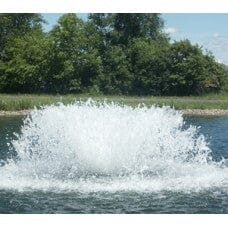What does a pond aerator do?
There are two kinds of pond aerators: surface aerators and bottom aerators. We will get to those shortly. But first, let’s look at why aeration is necessary in the first place.
Why Aeration is Necessary
Aeration keeps the water in the pond mixed year-round, so the pond isn’t shocked by a sudden turnover mix. You see, ponds naturally develop layers, with warmer water at the top and cooler at the bottom. This layering is called stratification. The problem is that this stratification undergoes shifts during the seasons and the different layers can mix too suddenly, causing pond turnover. So what does a pond aerator do? By using aeration, you can mix the layers year-round and even out the pond’s temperature. Oxygen is spread around so fish can thrive at various levels of depth. Necessary, natural bacteria thrive and bottom muck is reduced. The water becomes clearer, pond scum and invasive plants are reduced.
Also, without aeration, ponds can become shallower over time from a buildup of muck caused by a lack of oxygen. Plant materials need oxygen to steadily decompose, and if new plant life grows at a rate faster than old plants decompose (due to a lack of oxygen), muck accumulates at the bottom of the pond. If this occurs often, you will need to dredge the bottom of your pond occasionally. In addition, this muck sends up gas bubbles, which can create a very foul smell like rotten eggs.
Ways to Aerate
The most common type of aeration is surface aeration. Typically, a pump is attached to a float so that the entire unit rises and lowers with the water level. The pump agitates the water below and water crashes onto the pond from above, both decreasing stratification. In addition, water is forced into the air so that the pond’s water is always being recirculated.
There are three kinds of surface aerators:
Pure Surface Aerators 
The first one is merely an aerator. No display, just giant bubbles that kind of look like boiling water. These pure surface aerators are the most efficient surface aerators by far as there are no restrictions to the flow of water.
Decorative Fountain Aerators 
But fountains also aerate, just not as effectively as pure surface aerators. However, they have the advantage of being pretty to look at. There are two common kinds of fountains used for surface aeration. The most popular type is the decorative pond fountain. Usually, these include multiple nozzles, which can be changed fairly easily to provide different displays for different seasons. Several holes in each nozzle create each one’s intricate spray pattern. However, the holes restrict water flow to create their pattern, thus decreasing overall aeration capability.
Aerating Fountains 
Aerating Fountains provide only one kind of decorative display, the V-pattern. The flow is not restricted by an intricate nozzle and the pump uses a propeller rather than an impeller (as is used for decorative fountains). The effectiveness of these fountains for aeration lies between pure surface aerators and decorative fountains. They aerate a great deal more that decorative fountains, but less than pure surface aerators.
Bottom Aeration 
For very deep ponds, over 7’ or 8’, bottom aeration is recommended. The pumps used for surface aeration only draw water up to these depths, so water deeper than 7 or 8’ wouldn’t be affected by surface aeration. In bottom aeration, typically, an air compressor is located at the shore and a hose carries the air to a diffuser unit at the bottom of the pond. It is very similar to the air bubbles rising from the bottom of an aquarium. Currently, there are many fairly quiet air compressors available for sale. They need to be housed to protect from the elements, thus quieting them more. This kind of aeration is the most efficient and uses less electricity than surface aeration, as often only a ¼ hp air compressor is needed for a very large pond.
Final Words
In summary, aeration is needed to create a healthy pond environment. It can make you fish healthier and prevent fish kill, make your good plants thrive and unwanted plants to lose their hold on your pond. It can decrease muck buildup, stagnation, and mosquitoes.

